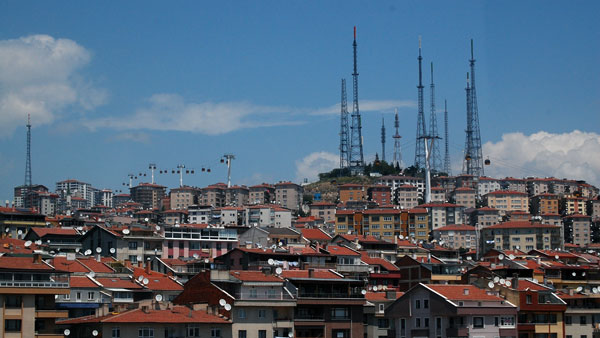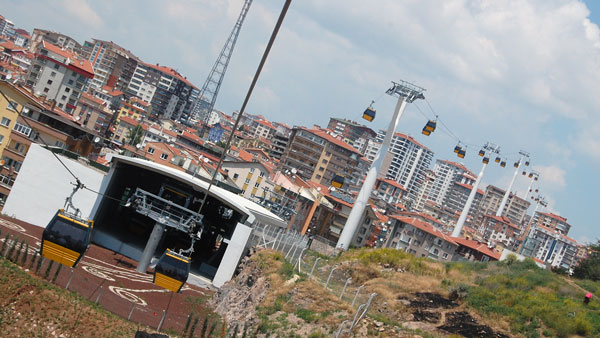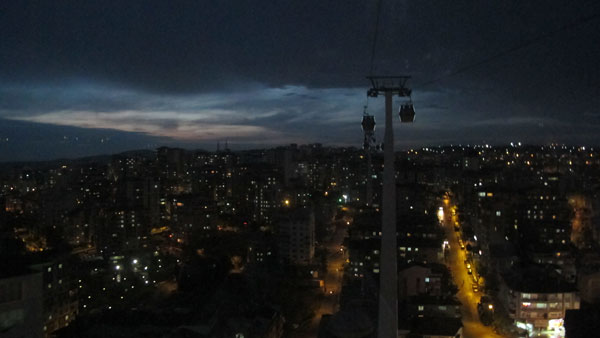
Yenimahalle Teleferik. Image by Steven Dale
Tell me if you’ve heard this one before —
A city in a developing or newly industrialized economy has some significant topographical challenges in an outlying neighborhood. To solve the problem, they build a four-to-six station long urban gondola system that’s between two-to-four kilometers in length with an offered capacity of two-to-four-thousand pphpd.
The citizens rejoice.
With the possible exception of mega-networks like that which is being built in La Paz, Bolivia, that’s pretty much been the story for urban gondolas over the last ten years. It’s as predictable as a mid-season episode of House.
The technology is always a Monocable Detachable Gondola, it’s always in a less-than-developed economy and it’s always of a certain size and length such that it acts as a feeder system for another higher order transit technology.
The new Ankara Cable Car (or if you prefer Yenimahalle Teleferik) follows that story template to a tee. It is, in many ways, a completely common urban gondola arrangement. The system serves a series of disconnected, hillside neighbourhoods; it’s four stations are spread over 3.2 kilometres with one connected to a metro station (Yenimahalle); and an offered capacity of 2,400 pphpd.
Interestingly, the first two sections were commissioned and opened last year with the final section opening earlier this year. This situation alone demonstrates the ability of the technology to be phased-in and expanded over time.
Ridership statistics, unfortunately, were not available at time of writing. Given the phased opening schedule, the government had decided to allow all users of the system to ride free-from-charge. As a result, ticketing kiosks were either not installed or not operational, hence the dearth of ridership values.
Nevertheless, during my two days in Ankara, riding the systems at all times of day the system was consistently busy. The system is clearly in the consciousness of the city. People were riding the system for amusement purposes as much as for transportation purposes. This was especially clear during the evening. Families could be seen disembarking at termini and then immediately re-boarding for a return trip, suggesting trips for pleasure rather than commuting.
That’s no surprise. The system itself looms large on the city’s skyline and is easily visible from numerous vantage points around the city. Why wouldn’t you want to ride it? You see it in the distance and you have a visceral want to ride the thing right now.
This is particularly true given how beautiful the ride is after dark when the lights of the city are visible from a myriad of different angles.
It’s hard to overstate this without sounding like I’m overselling it, but to ride the Yenimahalle Teleferik after dark is an urban experience like no other. Think about what it’s like to fly into a dense urban environment by plane after dark. Everyone’s eyes are fixated on the scenery below, lights twinkling in their eyes. That’s the experience you get in the Yenimalle Teleferik. But instead of peering through a tiny window over the shoulder of someone you don’t know, you get an entire 360 degree view — and uncannily close up.
It’s exceptional. Full stop.
Built by Leitner for an all-in price of €25mm, the Yenimahalle Teleferik is so reminiscent—from a capabilities perspective—of systems such as those in Medellin, it could be viewed as nothing more then the next me-too chapter in the urban gondola narrative.
Build this system in 2005 and it’s important. Build it in 2015 and it’s an also-ran. That would be the typical way to analyze this system. But that would also be incorrect.
As I mentioned yesterday, this is a system that breaks new ground in the urban gondola market by virtue of some of the most innovative and interesting station configurations we’ve ever seen.
As we’ll see in subsequent posts, the station designs challenge your thinking about how a gondola system can fit into the urban environment in ways that are both breath-taking and curious.
But leaving those stations for a separate discussion, the system becomes common. And there’s nothing wrong with that. It is, I would contend, a wonderful progression of the technology within a very specific feeder/circulator niche.
For cable car systems to eventually penetrate the mainstream consciousness of the transit planning apparatus, commonness is a necessity. The vast majority of buses, trains and subways, after all, are just that—common. It’s their banality that makes them attractive to planners. Predictability and unoriginality is the bread and butter of transit engineering.
All maturing technologies go through this process. If successful, novelty gives way to familiarity, which in turn allows a fledgling market to reach maturity. It then no longer becomes about inventing the ‘next killer app,’ it’s about creating minor, incremental improvements in the product as the years go by.
The Yenimahalle Teleferik shows that quite exquisitely.
ANKARA SERIES


